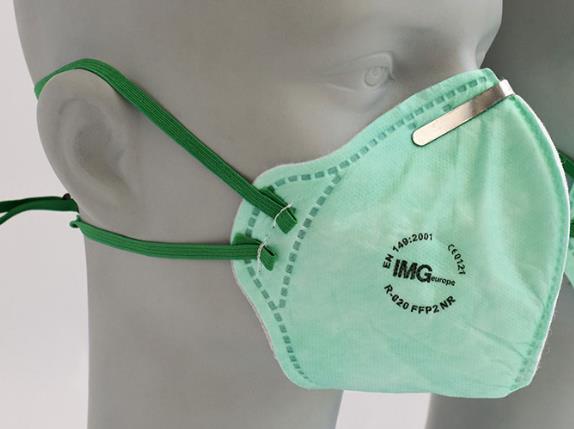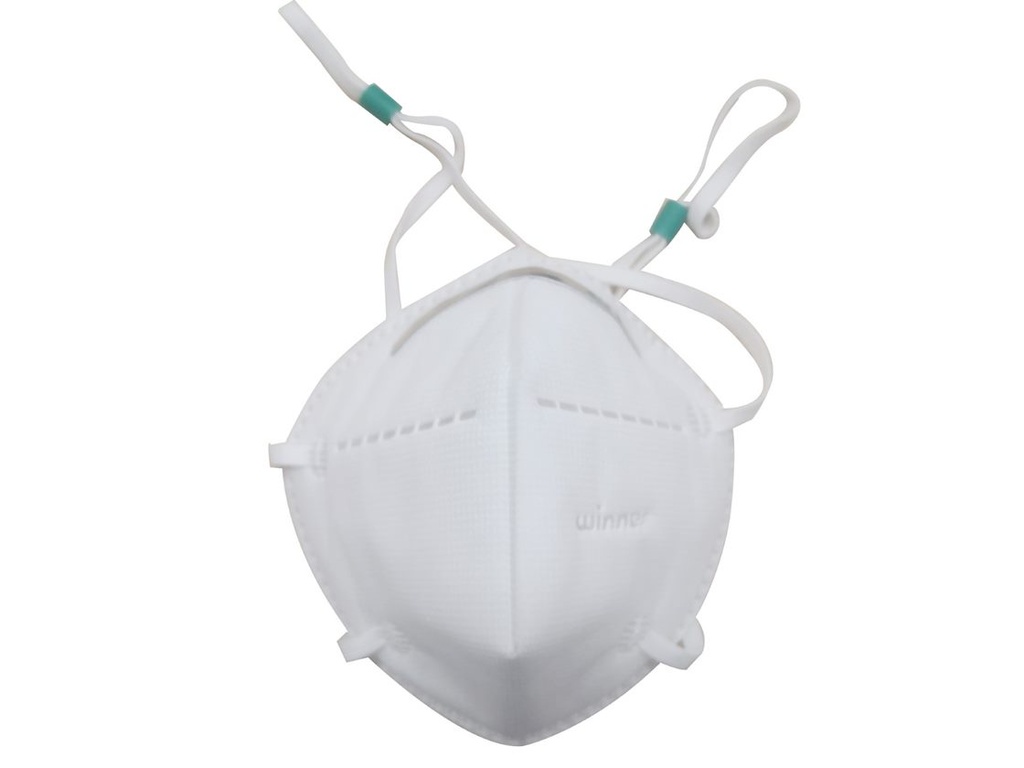RESPIRATOR FFP2/N95 + IIR, unvalved, vert.fold, M
Valid Article
RESPIRATOR
Definition
Personal Protective Equipment (PPE) for medical use
Filtering device covering nose, mouth and chin, used to protect the wearer against airborne or droplets transmitted infectious agents.
Filtering half mask: the facepiece consists entirely or substantially of filter material or comprises a facepiece in which the main filter(s) form an inseparable part of the device.
Specifications
Tuberculosis programmes
In order to determine which model or size of respirator is more suitable for the wearers, a respirator fit-test-kit (ELINMAFT1--) should be ordered together with samples of all available respirators.
VHF contexts
The respirator must not touch the face of the person
The respirator must be compatible with the Hood for VHF: SPPEHOOD2--
- First choice is the large duckbill design ELINMASP02L
- Second choice is the 3-panel design ELINMASP03M
- The other models are not appropriate for VHF / Ebola contexts
Quality standards
- EN 14683, 2019, Medical face masks - Requirements and test methods
- ISO 22609, 2004, edition 1, (confirmed 2020) Clothing for protection against infectious agents - Medical face masks - Test method for resistance against penetration by synthetic blood (fixed volume, horizontally projected)
Quality Standards Comment
Meets the specifications of either one of the following PPE standards:
- European standard FFP2 (EN 149+A1: 2009 "Respiratory protective devices - Filtering half masks to protect against particles - Requirements, testing, marking")
- American standard N95 (US NIOSH certification according: Respiratory Protective Devices, 42 CFR Part 84)
Most N95 respirators are manufactured for use in construction and other industrial type jobs that expose workers to dust and small particles. They are labeled "For occupational use.”
and cleared for medical use:
- EN 14683: 2019: Surgical masks - Requirements and test methods
- ISO 22609: 2004: Clothing for protection against infectious agents - Medical face masks - Test method for resistance against penetration by synthetic blood (fixed volume, horizontally projected) (confirmed in 2020)
N95 respirators that are cleared by FDA for use in health care settings are called Surgical N95 Respirators. The clearance of these respirators involves the evaluation of safety data from biocompatibility testing and performance testing from fluid resistance and flammability testing. In addition, the Surgical N95 Respirators are NIOSH-certified, which includes filtration efficiency and testing to demonstrate that the device meets the N95 respirator performance requirements.
- ASTM F1862/F1862M-17: Standard Test Method for Resistance of Medical Face Masks to Penetration by Synthetic Blood (Horizontal Projection of Fixed Volume at a Known Velocity)
See differences between surgical masks and respirators
Technical specifications
- Polypropelene, polyester, polyethylene, aluminium
- Meets the requirements of FFP2 or N95 (FFP2 or N95 must be written on the respirator itself)
- Filtration efficiency with 0.3 µm particles: > 95% (N95) or > 94% (FFP2)
- Total Inward Leakage (TIL): <10% (N95) or <8% (FFP2)
- Penetration of the filtering material < 6% (NaCl and paraffine at 95 l/min with particles of 0.6 µm)
- Meets the requirements of type II R:
- bacterial filtration efficiency (BFE) > or = 98%
- differential pressure (breathability) < 60 Pa
- splash resistance pressure > or = 120 mm Hg
- Covers the nose, the mouth and the chin and providing a tight seal around the edge
- Does not collapse against the mouth (WHO recommendation, PPE in case of risk of exposure to filovirus, 2016)
- Strong elastic straps around the head The head harness shall be designed so that the respirator can be donned and removed easily. The head harness shall be adjustable or self-adjusting and shall be sufficiently robust to hold the particle filtering half mask firmly in position and can maintain the total inward leakage requirements for the device.
- Without valve
- Non sterile, for single use
Packaging & Labelling
Box of 20 to 50 units
The following information shall be clearly and durably marked on the smallest commercially available packaging
- The appropriate class: FFP2
- "NR" if the particle filtering half mask is limited to single shift use only
- The number and year of publication of the European Standard
- At least the year of end of shelf life.
- Recommended conditions of storage (at least the temperature and humidity) or equivalent pictogram
The information supplied by the manufacturer
- shall accompany every smallest commercial available package
- shall contain all information necessary for trained and qualified persons on
- application/limitations
- the meaning of any color coding
- checks prior to use
- donning, fitting
- use
- storage
- the meaning of any symbols/pictograms used
Instructions for use
Prior to first use, perform a FIT TEST
Use the qualitative FIT TEST KIT (see related articles below) to select the respirator model and size that best fits the wearer's face.
The test must be renewed:
- at least once a year
- when changing to a new model/size
- in case of physical change of the face of the user
Everytime a respirator is put on, PERFORM A SEAL CHECK
Stand in front of a mirror and fully open the respirator
STEP 1: Cup the respirator in your hand with the nosepiece at your fingertips
STEP 2: Position the respirator under your chin with the nosepiece up in order to cover the chin, the mouth and the nose
STEP 3: Pull the top strap over your head resting it high at the back of your head. Pull the bottom strap over your head and position it around the neck below the ears
STEP 4: Mould the nosepiece (using two fingers of each hand), to the shape of your nose
STEP 5: Cover the respirator with both hands, being careful not to disturb the position of the respirator
- Inhale deeply in order to create an air vacuum: if the seal is good, the respirator will cling to your face
- Exhale sharply: if the seal is good, the respirator will slightly expand
- Inhale and exhale several times: no leakage of air between the face and the respirator may be detected
If problems are met (the respirator does not collapse neither expand or if air leak is detected), adjust the respirator and retest the seal. In case the problems persist, replace the respirator and/or try another model or size. Once the respirator is correctly fitted, don't manipulate it any longer.
Precautions for Use
- Respect the expiry date, if only manufacturing date is mentioned on the package: discard if older than 5 years (make sure to have new stock in replacement first). If no dates can be found: check elasticity of the headband before putting on
- Facial hair that lies along the sealing area of a respirator, such as beards, sideburns, or some mustaches, will interfere with respirators that rely on a tight facepiece seal to achieve maximum protection," per the post. "Facial hair is a common reason that someone cannot be fit tested. Per the CDC, face hair "should not cross under the respirator sealing surface"
Storage
- Store between 5 and 40°C
- In a dry and well-ventilated place







![[ELINMAFT1--] FIT TEST KIT, qualitative testing of FFP2/N95 respirators](/web/image/product.template/573121/image_256/%5BELINMAFT1--%5D%20FIT%20TEST%20KIT%2C%20qualitative%20testing%20of%20FFP2-N95%20respirators?unique=b82bf39)